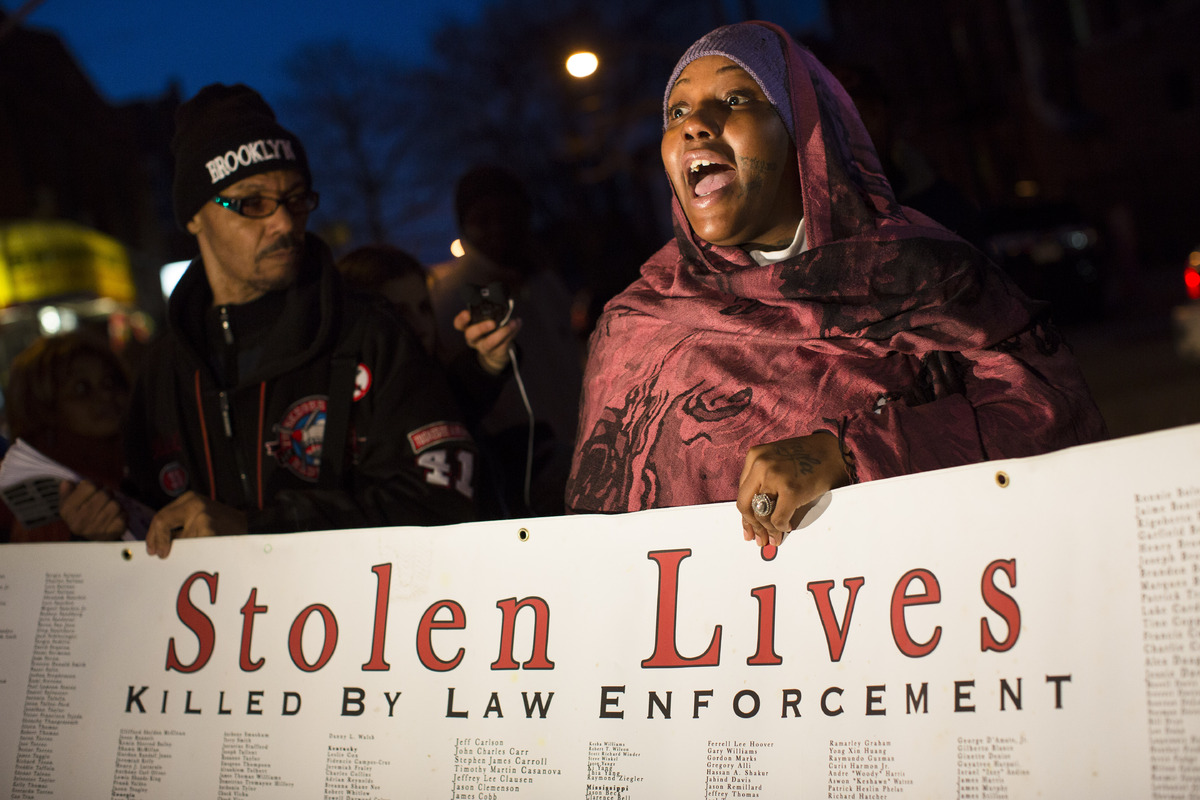
New York City's Office of Emergency Management issued a citywide brush fire warning last week. Authorities said that dry weather conditions combined with strong winds could turn the ember of an abandoned cigarette into an inferno. But New York police officers who stared down the young men and women emptying rain water from candles on the corner of 55th Street and Church Avenue on Easter Sunday were watching for a different sort of fire.
The candles are arranged to spell “Kiki”, a black youth whose recent killing by the police has dropped a match into a fuel bucket of anger over what critics describe as systemic racism on the part of the New York City Police Department. Whereas firefighters use water to put out blazes, the NYPD have used truncheons and pepper-spray to squelch the outrage burning in the streets. Their tactics of suppression have only deepened the sense of distrust and resentment the community feels towards the blue uniforms on their blocks.
Kiki, birth name Kimani Jamani Gray, was known as a dedicated student to his teachers at the Urban Assembly School in Midtown Manhattan, and a joker and ladies man to his friends. But Kiki wasn't a man yet. He was 16 years old when he was gunned down by two undercover narcotics officers with the 67th Precinct while leaving a party on the evening of March 9.
Officers Mourad Mourad and Jovaniel Cordova put seven bullets in him; three entered his body from behind. Police insist that he was brandishing a gun, but the sole evidence released by the NYPD to support this claim is a photograph of a revolver taken on a police station table. Questions continue to swirl around the killing.
“I want to see the ballistics test,” said council member Jumaane Williams, who represents East Flatbush where Kimani lived and died. “I want to see the finger prints on the gun. But what the NYPD does is jump the gun and start trying the case in the media.”Police say Gray was a member of the Bloods gang and have released his juvenile record to the press. Speaking at the Easter memorial, Carol Gray sought to clear her son's name. “What gangster comes home at night and gives his nieces and nephews a bath?” she asked, “What gangster makes his bed in the morning?”
Carol added that while Easter is supposed to be a celebration of the Lord's resurrection, “All I can think about is Kiki. I keep expecting him to come home.”
In a sense, Carol's son has been resurrected, as chants of “We are all Kimani Gray!” have rung out up and down Church Avenue since his death. Kimani has become emblematic of so many lives snatched early in New York, where killings by police are on the rise.
Last June, just blocks from where Gray was killed, 23-year-old Shantel Davis was shot in the stomach after crashing a car police say was stolen. Davis, who was unarmed, was dragged from the vehicle by her shooter, Officer Philip Atkins, and eventually bled to death in the street. The incident occurred in broad daylight and there were many witnesses.
Officers confiscated cellphones that had captured the killing, supposedly to be used for evidence. The Brooklyn District Attorney's Office says it is investigating, but ten months on, the Davis family is still waiting for answers.
Two months prior to that shooting, 27-year-old Tamon Robinson died when he was hit by a squad car. Officers had pursued Robinson in their vehicle, mistakenly believing that he was stealing construction materials. Robinson's mother was later sent a bill totaling $710 for damages to the police cruiser that killed her son.
A total of 19 New Yorkers were killed by police in 2012, up from 13 the year before, according to researchers with the Stolen Lives Project. In all but one of the deaths, no charges have been filed. The case of Ramarley Graham is the exception. Anti-police brutality activists and the Graham family credit both public pressure and evidence that contradicted the NYPD's original version of events surrounding their son's killing.
Officer Richard Haste shot the 18-year-old in the bathroom of his Bronx home in front of his grandmother and 6-year-old brother. Haste had originally claimed he was in hot pursuit of Ramarley when the incident occurred. Surveillance footage says otherwise. It shows Haste and other officers kicking down the door to Graham's home, minutes after he entered the building from the opposite direction. The case against Haste is currently lurching through the court system and he likely won't go on trial for another year.
In East Flatbush, the cops who killed Davis and Gray – officers Atkins, Mourad and Cordova – can be found behind the desk at the 67th Precinct. The three had previously accumulated more than $300,000 between them in payouts made by the city to victims of abuse and false arrests in their hands.
“For a lot of the these police officers the bar is too low,” said council member Williams, “I don't know any other place where you can make a mistake, someone dies and nothing happens; nobody apologizes, nobody says anything, people still have their jobs.”
But the slayings are just the most extreme form of what critics describe as racist policing.
Like so many other black and brown communities in New York, East Flatbush has long been under the boot of the NYPD. The force's day-to-day instrument of social control comes in the form of its “Stop, Question and Frisk” policy, whereby officers patrol the streets and stand at subway entrances interrogating and reaching into the pockets of mainly young men of color.
Furtive movements and the wearing of clothes commonly worn in a crime – hoodies and gloves for instance – are often given as accuses for stops, but since nearly 90 percent of those targeted are of color, critics charge that race is the underlying factor. The stop-and-frisk policy is currently on trial in a federal class action suit in New York in which the Center for Constitution Rights is arguing that it constitutes arbitrary and unconstitutional harassment.
During the trial recently, New York State Senator and 20-year NYPD veteran Eric Adams testified that in a private meeting last year, Police Commissioner Ray Kelly disclosed to him that stop-and-frisk was designed “to instill fear” in blacks and latinos with the knowledge that “any time they leave their homes they could be targeted by police."
Kimani's death ignited the outrage stop-and-frisk had left under the surface in East Flatbush. “They are terrorizing us,” said former Black Panther Charles Barron, who like Williams is on the City Council and has sought to hold the police accountable for the Kimani's killing.
“We're living under a greedy, monopoly-capitalist system that keeps people impoverished and unemployed, that closes down schools and youth centers and puts us out here with drugs and guns and police. It's a powder keg situation.”
Two days after Kimani died, that powder keg exploded when a vigil in East Flatbush morphed into a spontaneous march to the 67th Precinct. Events took a violent turn as teenagers holding yellow “Kiki Forever” balloons in their hands were manhandled by officers. In response, the youth let their balloons drift up into the night and picked up bottles which they hurled at police. Fruit carts were tipped over, car windows smashed.
Though protests have largely been nonviolent since then, nightly marches to the 67th precinct have been stalked by cops on scooters, cops on foot, cops on horses, cops in vans, and cops three to a rooftop.
Scenes of unrest have spread beyond Brooklyn. On Saturday in Queens, riot troops were deployed when residents of a local housing project hurled projectiles at police and marched on the 113th Precinct after they witnessed officers beating two young men.
But by Easter outright tensions in East Flatbush seemed to have smouldered down. Police who had been clustered 24-7 on corners for more than a mile down Church Avenue had mostly withdrawn, but approximately 20 still hung around the memorial site, keeping a few dozen paces from where friends and family stood paying their respects to Kiki.
Someone caught Carol Gray's eye. “Oh my lord,” she said approaching a black youth in a white hoodie, one of those whom, like Kimani, Ray Kelly hopes to instill with fear. There's a look of expectation in Carol's eyes but as she gets closer to the teenager it breaks into tears. “I thought, you were Kiki,” she says.
“No,” he sighed, embracing her, “I was a friend of his.”
Later, Carol addressed friends, family and supporters. “I pray that you guys stand up with me,” she said, “for Kimani, and Shantel and Ramarley and all the other kids who have been brutalized and killed. We want to fight for them. We want justice for them.”
3 WAYS TO SHOW YOUR SUPPORT
- Log in to post comments














